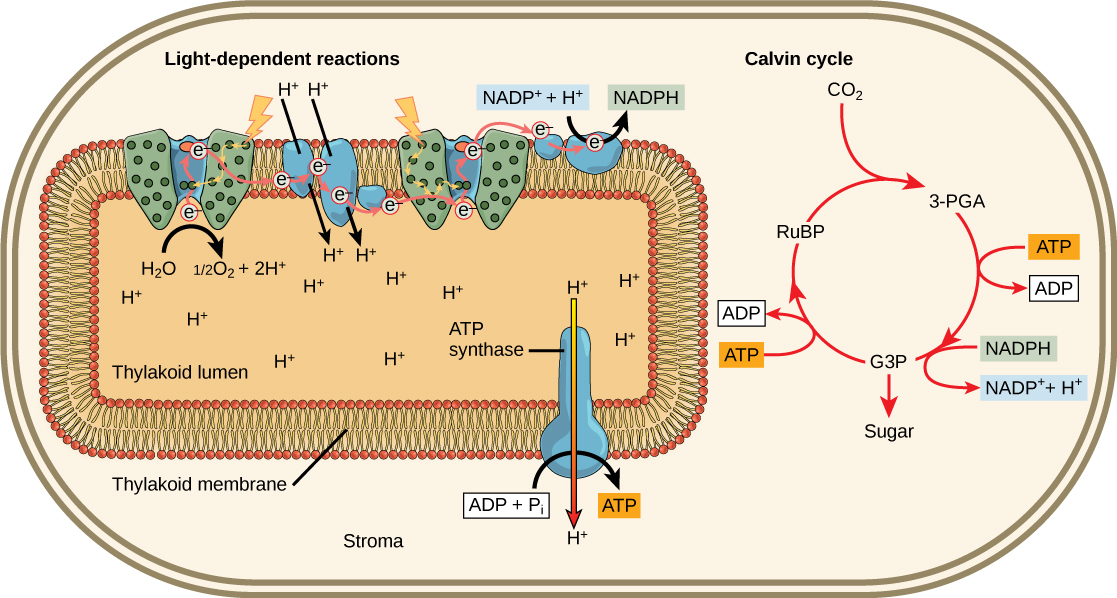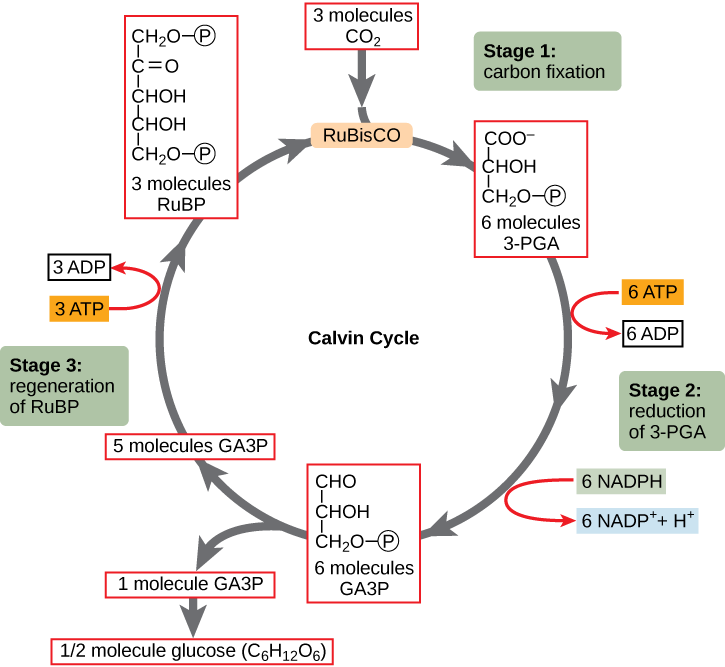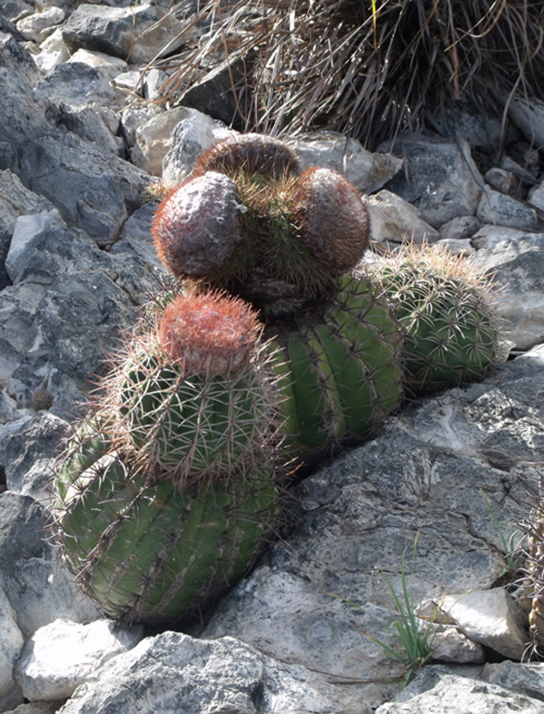8.3: 利用光能制造有机分子
- Page ID
- 202679
培养技能
- 描述加尔文循环
- 定义碳固定
- 解释光合作用在所有活生物体的能量循环中是如何工作的
来自太阳的能量转化为化学能并暂时储存在ATP和NADPH分子中后,细胞就有了制造碳水化合物分子所需的燃料,以实现长期能量储存。 光依赖反应的产物ATP和NADPH的寿命在百万分之一秒之间,而光无关反应(碳水化合物和其他形式的还原碳)的产物可以存活数亿年。 所产生的碳水化合物分子将具有碳原子的支柱。 碳来自哪里? 它来自二氧化碳,二氧化碳是微生物、真菌、植物和动物呼吸的废物。
Calvin Cycle
在植物中,二氧化碳(CO 2)通过气孔进入叶子,然后通过细胞间空间短距离扩散,直到到达叶肉细胞。 一旦进入叶肉细胞,二氧化碳就会扩散到叶绿体的基质中,叶绿体是光合作用无关反应的部位。 这些反应实际上有几个与之相关的名称。 另一个名词是加尔文循环,以发现它的人命名,因为这些反应起着循环的作用。 其他人则称之为加尔文-本森周期,其中包括另一位参与其发现的科学家的名字。 最过时的名称是暗色反应,因为光不是直接需要的(图\(\PageIndex{1}\))。 但是,“暗反应” 一词可能具有误导性,因为它错误地暗示该反应仅发生在夜间或与光无关,这就是大多数科学家和教师不再使用它的原因。

加尔文循环中与光无关的反应可以分为三个基本阶段:固定、还原和再生。
第 1 阶段:固定
在基质中,除二氧化碳外,还有另外两种成分可以引发光无关反应:一种叫做核糖-1,5-二磷酸羧化酶/加氧酶(ruBisco)的酶和三个核酮糖二磷酸盐(ruBP)分子,如图所示\(\PageIndex{2}\)。 RuBP 有五个碳原子,两侧是两个磷酸盐。
艺术连接

以下陈述中哪一项是正确的?
- 在光合作用中,氧气、二氧化碳、ATP 和 NADPH 是反应物。 GA3P 和水是产品。
- 在光合作用中,叶绿素、水和二氧化碳是反应物。 GA3P 和氧气是产物。
- 在光合作用中,水、二氧化碳、ATP 和 NADPH 是反应物。 RuBP 和氧气是产物。
- 在光合作用中,水和二氧化碳是反应物。 GA3P 和氧气是产物。
Rubisco 催化二氧化碳和 ruBP 之间的反应。 对于与一个 ruBP 发生反应的每个 CO 2 分子,就会形成另一种化合物 (3-PGA) 的两个分子。 PGA 有三个碳和一个磷酸盐。 循环的每回合只涉及一个 ruBP 和一个二氧化碳,形成两个 3-PGA 分子。 碳原子的数量保持不变,因为原子在反应过程中会移动以形成新的键(来自 3CO 2 的 3 个原子 + 来自 3rubP 的 15 个原子 = 3 个 PGA 原子中的 18 个原子)。 这个过程被称为固碳,因为二氧化碳从无机形态 “固定” 到有机分子。
第 2 阶段:减免
ATP 和 NADPH 用于将 3-PGA 的六个分子转化为一种叫做 3-磷酸甘油醛 (G3P) 的化学物质的六个分子。 这是一种还原反应,因为它涉及3-PGA的电子增益。 回想一下,还原是原子或分子对电子的增益。 使用了 ATP 和 NADPH 的六个分子。 对于 ATP 来说,能量随着末端磷酸盐原子的损失而释放,将其转化为 ADP;对于 NADPH 来说,能量和氢原子都会丢失,将其转化为 NADP +。 这两个分子都会返回附近的光依赖反应,以便重复使用和恢复活力。
第 3 阶段:再生
有趣的是,在这一点上,只有一个G3P分子离开了加尔文循环并被送到细胞质以促进植物所需的其他化合物的形成。 由于从叶绿体出口的G3P有三个碳原子,因此需要加尔文循环的三圈 “回合” 才能固定足够的净碳来输出一个G3P。 但是每回合产生两个 G3P,因此三回合产生六个 G3P。 一个被输出,剩下的五个 G3P 分子留在循环中,用于再生 ruBP,这使系统能够为修复更多的二氧化碳做好准备。 在这些再生反应中又使用了三个 ATP 分子。
进化连接:光合作用
在光合作用的演变过程中,发生了重大转变,从仅涉及一个光系统且通常是缺氧(不产生氧气)的细菌类型的光合作用转变为使用两个光系统的现代氧气(确实会产生氧气)光合作用。 这种现代的氧气光合作用被许多生物所使用,从雨林中的巨型热带树叶到微小的蓝细菌细胞,这种光合作用的过程和组成部分基本保持不变。 光系统吸收光并使用电子传输链将能量转化为 ATP 和 NADH 的化学能。 随后的与光无关的反应然后用这种能量组装碳水化合物分子。
沙漠植物的光合作用已经形成了节约用水的适应能力。 在严酷的干燥高温下,必须使用每一滴水才能生存。 由于气孔必须打开才能吸收二氧化碳,因此在活跃的光合作用过程中,水会从叶片中逸出。 沙漠植物已经发展出节水和应对恶劣条件的工艺。 更有效地使用二氧化碳可以使植物适应用更少的水的生活。 一些植物,例如仙人掌(图\(\PageIndex{3}\)) can prepare materials for photosynthesis during the night by a temporary carbon fixation/storage process, because opening the stomata at this time conserves water due to cooler temperatures. In addition, cacti have evolved the ability to carry out low levels of photosynthesis without opening stomata at all, an extreme mechanism to face extremely dry periods.

The Energy Cycle
Whether the organism is a bacterium, plant, or animal, all living things access energy by breaking down carbohydrate molecules. But if plants make carbohydrate molecules, why would they need to break them down, especially when it has been shown that the gas organisms release as a “waste product” (CO2) acts as a substrate for the formation of more food in photosynthesis? Remember, living things need energy to perform life functions. In addition, an organism can either make its own food or eat another organism—either way, the food still needs to be broken down. Finally, in the process of breaking down food, called cellular respiration, heterotrophs release needed energy and produce “waste” in the form of CO2 gas.
In nature, there is no such thing as waste. Every single atom of matter and energy is conserved, recycling over and over infinitely. Substances change form or move from one type of molecule to another, but their constituent atoms never disappear (Figure \(\PageIndex{4}\)).
CO2 is no more a form of waste than oxygen is wasteful to photosynthesis. Both are byproducts of reactions that move on to other reactions. Photosynthesis absorbs light energy to build carbohydrates in chloroplasts, and aerobic cellular respiration releases energy by using oxygen to metabolize carbohydrates in the cytoplasm and mitochondria. Both processes use electron transport chains to capture the energy necessary to drive other reactions. These two powerhouse processes, photosynthesis and cellular respiration, function in biological, cyclical harmony to allow organisms to access life-sustaining energy that originates millions of miles away in a burning star humans call the sun.

Summary
Using the energy carriers formed in the first steps of photosynthesis, the light-independent reactions, or the Calvin cycle, take in CO2 from the environment. An enzyme, RuBisCO, catalyzes a reaction with CO2 and another molecule, RuBP. After three cycles, a three-carbon molecule of G3P leaves the cycle to become part of a carbohydrate molecule. The remaining G3P molecules stay in the cycle to be regenerated into RuBP, which is then ready to react with more CO2. Photosynthesis forms an energy cycle with the process of cellular respiration. Plants need both photosynthesis and respiration for their ability to function in both the light and dark, and to be able to interconvert essential metabolites. Therefore, plants contain both chloroplasts and mitochondria.
Art Connections
Figure \(\PageIndex{2}\): Which of the following statements is true?
- In photosynthesis, oxygen, carbon dioxide, ATP, and NADPH are reactants. G3P and water are products.
- In photosynthesis, chlorophyll, water, and carbon dioxide are reactants. G3P and oxygen are products.
- In photosynthesis, water, carbon dioxide, ATP, and NADPH are reactants. RuBP and oxygen are products.
- In photosynthesis, water and carbon dioxide are reactants. G3P and oxygen are products.
- Answer
-
D
Glossary
- Calvin cycle
- light-independent reactions of photosynthesis that convert carbon dioxide from the atmosphere into carbohydrates using the energy and reducing power of ATP and NADPH
- carbon fixation
- process of converting inorganic CO2 gas into organic compounds
- reduction
- gain of electron(s) by an atom or molecule



